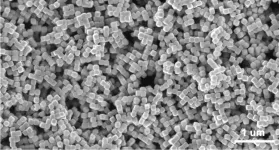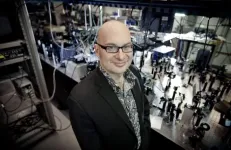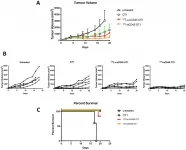(Press-News.org) In most animal species, if a major artery is cut off from the heart, the animal will struggle to survive. The same can be said for many of our critical infrastructure systems, such as electric power, water and communications. They are networked systems with vulnerable connections.
This vulnerability was on display in September 2017 when Hurricane Maria wrecked Puerto Rico's electric power grid, leaving almost all of the island's 3.3 million people without electricity. The months-long blackout that followed was the worst in U.S. history.
Claire Trevisan, then a civil and environmental engineering undergraduate student in the Department of Engineering Systems and Environment at the University of Virginia, took note of Puerto Rico's plight. She asked her fourth-year capstone advisor, professor and associate director of the UVA Environmental Resilience Institute Andres Clarens, if they could use her project to study the problem.
Trevisan's capstone became the impetus behind a critical improvement to the energy system optimization models engineers use to plan infrastructure: Integrating impacts of future hurricanes into decisions about how grids are designed. An interdisciplinary team led by UVA Ph.D. student Jeffrey Bennett and including collaborators from North Carolina State University and the University of Puerto Rico at Mayagüez just published the research in the journal Nature Energy.
Their research demonstrates that modernizing power grids by using more renewable energy sources distributed across the landscape will cost less than repairing hurricane damage to a centralized grid.
Optimization models analyze data to find the cheapest way to deliver power under a set of constraints. Established models already account for costs related to construction, fuels, emissions and resilience -- meaning the system's ability to recover if something disrupts operation -- but the costs of predictable damage from events such as hurricanes, wildfires and floods are not built into existing models.
"In the past, people didn't know how often hurricanes would hit and what kind of damage they would do," Clarens said. "Now we do know those things, and we have the computing power to actually run simulations to say, 'Okay, if we build it this way, how much more is it going to cost your electricity customers?'"
How the grid is configured, or its topology, is integral to the team's research. When the United States was electrified a century ago, the most efficient way to deliver power to customers involved centralized generation plants feeding electricity over a huge network. That was true even with the risk of widespread outages when a main power station or transmission artery was disrupted.
The researchers wanted to examine what happens as grids are gradually redesigned to support more renewable energy sources, which is already underway in much of the country with solar and wind generation. The model can identify the combinations of generation sources that make the most economical sense when you anticipate the cost of hurricane repairs.
"The ability to do this is important because the frequency and severity of storms are increasing as a result of climate change," Clarens said.
Puerto Rico is a good case study to apply the model. The island has been in the path of 13 named storms over the past 25 years. The existing grid architecture remains outdated today, and the system relies on imported fossil fuels, making power expensive. On the other hand, Puerto Rico has abundant solar and wind resources.
One problem in planning, Bennett said, is that government policies such as emissions controls and market conditions -- including decreasing costs of wind and solar energy production and storage -- can create "stranded assets," expensive, built-to-last power plants that end up being retired early because they're no longer economical to run.
Given the large number of policy- and weather-related combinations that could happen in the future, the team needed to run the model on UVA's supercomputer, Rivanna.
"In our study, we simulate the likelihood and intensity of a storm hitting the grid in each five-year time step. The hurricane intensity is used to predict the wind speed and project damage to the electric grid infrastructure," Bennett said.
"The system then builds new infrastructure to be able to meet electricity demand. By considering combinations of hurricane intensities and probabilities, we are then able to project average electricity costs and examine how infrastructure investments vary. Our results show that hurricanes increase electricity costs by 32% based on historical hurricane trends, and more if you consider that storms are increasing in frequency and severity as a result of climate change. Transitioning to renewables and natural gas reduces costs and emissions regardless of hurricane frequency."
Although the research addresses wind damage to the electric power grid brought on by hurricanes, the team's approach can be applied to other weather- and climate-related disasters, Clarens said.
"With this approach to grid decision-making, you can also look at cases like wildfires in the American West and floods in the Midwest," he said. "There are changes to the climate that are impacting our engineered systems. We're trying to develop new tools and new insights that can help us to say, 'Look, the past is not a good model for the future anymore. We need new ways to simulate the future so that we can make the best decisions possible.'"
INFORMATION:
Oncotarget recently published "PD-1/PD-L1 expression in anal squamous intraepithelial lesions" which reported that the presence and distribution of CD8 lymphocytes and the presence of PD-1 lymphocytes and PD-L1 epithelial cells were assessed.
CD8 lymphocytes were observed more frequently in HSIL versus LSIL in the lamina propria or intra epithelial.
PD-1 lymphocytes were observed more frequently in HSIL versus LSIL.
There was no difference between HSIL and LSIL for PD-L1 epithelial cells.
Anal dysplastic lesions are accompanied by an inflammatory lymphocytic infiltrate expressing CD8 and PD-1, more frequent in high-grade lesions.
Dr. ...
A team led by University of Minnesota Twin Cities researchers has discovered a groundbreaking one-step process for creating materials with unique properties, called metamaterials. Their results show the realistic possibility of designing similar self-assembled structures with the potential of creating "built-to-order" nanostructures for wide application in electronics and optical devices.
The research was published and featured on the cover of Nano Letters, a peer-reviewed scientific journal published by the American Chemical Society.
In general, metamaterials are materials made in the lab so as to provide specific physical, chemical, electrical, and optical properties otherwise impossible to find in naturally occurring materials. These materials can ...
HOUSTON - (Jan. 11, 2021) - A sweet new process is making sour more practical.
Rice University engineers are turning carbon monoxide directly into acetic acid -- the widely used chemical agent that gives vinegar its tang -- with a continuous catalytic reactor that can use renewable electricity efficiently to turn out a highly purified product.
The electrochemical process by the labs of chemical and biomolecular engineers Haotian Wang and Thomas Senftle of Rice's Brown School of Engineering resolves issues with previous attempts to reduce carbon monoxide (CO) into acetic acid. Those processes required additional steps to purify ...
(Boston)--Little previous research has examined the effects of Dense Breast Notifications (DBNs), but a new study suggests the legislatively required notifications have achieved partial success: women living in states in which in DBNs are mandated had higher rates of being informed about personal breast density and of having had breast density discussions with providers, though rates were low overall.
DBNs are a written notification to a woman after a mammogram with information about breast density. The goal is to motivate her to speak with her doctor about her personal risk and determine if supplemental screening for breast cancer is appropriate. DBNs are mandated in more than 38 states and the Food Drug ...
Scientists from the University of Bath have made a sustainable polymer using the second most abundant sugar in nature, xylose.
Not only does the new nature-inspired material reduce reliance on crude oil products, but its properties can also be easily controlled to make the material flexible or crystalline.
The researchers, from the University's Centre for Sustainable and Circular Technologies, report the polymer, from the polyether family, has a variety of applications, including as a building block for polyurethane, used in mattresses and shoe soles; as a bio-derived alternative to polyethylene glycol, a chemical widely used in bio-medicine; or to polyethylene oxide, ...
An international team of researchers, including Professor END ...
PHILADELPHIA -- (Jan. 11, 2020) -- Mutations that inactivate the ARID1A gene in ovarian cancer increase utilization of the glutamine amino acid making cancer cells dependent on glutamine metabolism, according to a study by The Wistar Institute published online in Nature Cancer. Researchers also showed that pharmacologic inhibition of glutamine metabolism may represent an effective therapeutic strategy for ARID1A-mutant ovarian cancer.
Up to 60% of ovarian clear cell carcinomas (OCCC) have inactivating mutations in the ARID1A tumor suppressor gene. These ...
Oncotarget recently published "Targeted lymphodepletion with a CD45-directed antibody radioconjugate as a novel conditioning regimen prior to adoptive cell therapy" which reported that Chimeric antigen receptor T cell therapies, and adoptive cell therapy in general, represent one of the most promising anti-cancer strategies.
In contrast to relatively non-specific chemotherapy-derived lymphodepletion, targeted lymphodepletion with radioimmunotherapy directed to CD45 may be a safer and more effective alternative to target and deplete immune cells. Here the authors describe the results ...
For the brain to learn, retain memories, process sensory information, and coordinate body movements, its groups of nerve cells must generate coordinated electrical signals. Disorder in synchronous firing can impair these processes and, in extreme cases, lead to seizures and epilepsy.
Synchrony between neighboring neurons depends on the protein connexin 36, an essential element of certain types of synaptic connections that, unlike classical chemical synapses, pass signals between neurons through direct electrical connections. For more than 15 years, scientists have debated the tie between connexin 36 and epilepsy.
Now, a team of Virginia Tech scientists led by Yuchin Albert Pan, an associate professor at the Fralin Biomedical Research ...
Many policymakers and educational institutions hope to boost their economies by stimulating students' entrepreneurial intentions. To date, most research concluded that entrepreneurship education could increase these intentions by improving the image that students have of entrepreneurship as a career option, making them see how their environment can help them become entrepreneurs or increasing their self-confidence regarding their entrepreneurial skills. However, recent studies show that even if these goals are achieved, students' entrepreneurial intentions often ...






